Travel
The 5 Scottish golf trips you should book right now

Dom Furore
With The Open on our TVs this week, golfers from around the world will be dreaming about booking their next golf trip to the United Kingdom. And with travel opening back up for the moment, now's the time to start arranging your trip for 2022 (things are booking up quickly!).
We worked with our friends at Golfbreaks by PGA TOUR to package together the best options to Scotland. There are so many trips you can take within Scotland—we separated each by region, including some options for lodging and the best courses to consider playing. Have fun planning!
Note: Travel restrictions and protocols are changing weekly in Europe for North American travelers. Be sure to consult the latest local rules before booking your trip.
Highlands
Our favorite Scottish trip is probably the Highlands (northern Scotland), offering some of the best and most authentic links golf in the country. In Inverness, known as “The Capital of the Highlands,” a handful of great lodging options will provide golfers easy access to bucket-list courses.

The Kingsmills Hotel (above) is located just a mile from the center of the city, has two onsite restaurants and 147 rooms. Its fleet of cars can transport up to six people to the nearby courses. Those requesting chauffeur service will have a driver at their disposal to offer local knowledge and insight for the duration of their trip.
The Sandown House used to be a farm that has since been transformed into a beautiful guesthouse just outside of Nairn, right in the heart of the Scottish highlands and only 10 minutes from Inverness airport. There are just six rooms in the house, but award-winning breakfast, made-to-order with local ingredients, is included with your stay.
The Glen Mhor Hotel & Apartments are right in the center of Inverness on the banks of the River Ness. Of the three lodging options listed, this one falls into the “budget option” category, for those perhaps more interested in spend more on golf than sleeping arrangements. Located within walking distance of shops, restaurants and bars the Glen Mhor Hotel is perfect for exploring the city.
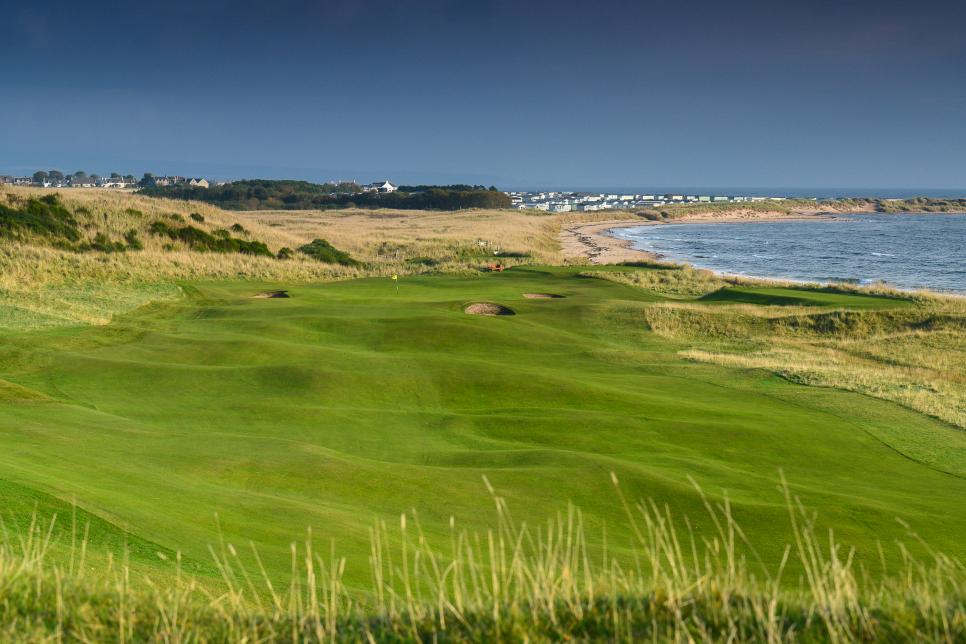
Kevin Markham
Each of these options offer quick and easy access to some of the Highlands’ best golf. Royal Dornoch’s Championship Course (above) not only tops the list of best golf in the Highlands, but it’s No. 4 on Golf Digest’s World’s 100 Greatest Golf Courses. After playing here, Tom Watson said it was the most fun he’d ever had playing golf. If not for being so far north, this course may have already hosted Open Championships. Old Tom Morris designed this gem in 1895 along the Dornoch Firth and its famous “upturned saucer” greens. This is the perfect place to forget a scorecard and just enjoy a round in one of the most authentic golf settings in the world. Dornoch is also the birthplace of Donald Ross, one of the world’s most famous golf architects. Royal Dornoch was a major influence on many course designs in America, particularly with Ross.
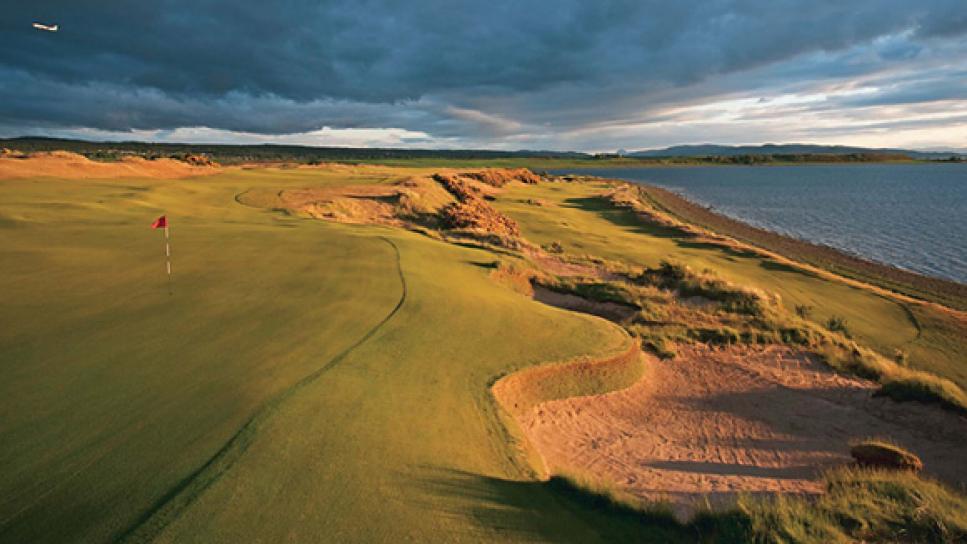
Upon opening in 2009, Castle Stuart (above) quickly entered Golf Digest’s World’s 100 Greatest rankings, most recently finishing in a tie for 60th. Gil Hanse and Mark Parsinen designed the course along the Moray Firth with scoring in mind. Castle Stuart offers a handful of short par 4s that present risk/reward situations and a mix of long and short par 3s that will test irons up and down a player’s bag. That’s not to say Castle Stuart is “easy,” but it is a different type of test than some of the more traditional courses in the British Isles. As different and brilliantly constructed as it is, it still fits seamlessly into the style of golf found in the region. Though more than a century younger than some of the oldest courses in Scotland, Castle Stuart has already hosted several Scottish Opens and Parsinen hopes to host an Open Championship before long.
Another must-play course in the Scottish Highlands is Nairn. Host to Curtis and Walker Cups, this 1887 design is famous for its narrow, gorse- and heather-lined fairways and fast and true greens. Nairn’s natural hazards and undulations will test a golfer of any level—and Scottish travelers always cite Nairn as one of the most fun rounds in Scotland. Its first seven holes play directly along the Moray Firth, but the sea can be seen from all 18 holes.
Golfers also say Brora Golf Club is a must-play when traveling through Dornoch. Just 15 minutes past Royal Dornoch, this seaside links isn’t the easiest course to get to, but it is well worth the trouble. A traditional out-and-in links, the first nine holes are situated right along the North Sea as the second nine play straight back to the clubhouse. Views of the water are unobstructed, but beware, that means no dunes to provide any protection from whipping winds. Sheep and cattle roam free, which means the rough is kept nice and short, a key for those who may be struggling to keep their ball in the fairway in the wind. Five-time Champion Golfer of the Year Peter Thompson once said Brora was his favorite course in the world.
There are two courses at Moray Golf Club, an hour east of Inverness, but it’s the Old Course that is recognized as one of the best in Scotland. This Old Course was designed by Old Tom Morris (more info on the Old Course at St. Andrews below). The rippled fairways, gorse bushes, pot bunkers and smooth greens the British Isles are known for are aplenty here. Seven par 4s stretching over 400 yards offer a stern test, especially with the wind that is sure to be whipping off the North Sea. Be sure to avoid “Hell’s Bunker” that protects the 18th green to finish your round in style.
Back up north, Carnegie Links at Skibo Castle is another must-play on the Dornoch Firth. Set on a breathtaking peninsula with the Dornoch Firth to the south and the River and Loch Evelix to the north, Carnegie Links offers over 6,800 yards of championship-level golf. There are no tee times, so members are free to play when they want. Tee times have recently been made available to the public, so they, too, may experience the brilliance of the course.
Interested in booking one of these trips? Click here to start pricing out your trip with our friends at Golfbreaks by PGA TOUR, or call them: (+1) 843.779.7134.
Aberdeenshire
Aberdeenshire’s coastline is home to some of the best links golf anywhere in the world. The 165-mile coastline is peppered with golf courses and sand dunes that reach up to 100 feet high. The city of Aberdeen is known as the oil capital of Europe. With such a title comes the restaurant, pub and social scene to match so the fun doesn’t have to end on the golf course.

Just 30 minutes outside Aberdeen, nestled in the countryside is the Meldrum House Hotel (above), a 13th-century country house with 51 rooms and an on-site parkland golf course. The Knight’s Course serves as an introduction to the famous links courses of the region.
For a bit less coin, travelers can stay at the Jurys Inn Aberdeen, right in the heart of the city. This 203-bedroom hotel is within walking distance of bars, restaurants and a shopping mall. No more than 40 minutes from any of the major courses in the area, this lodging option offers tremendous bang for your buck.
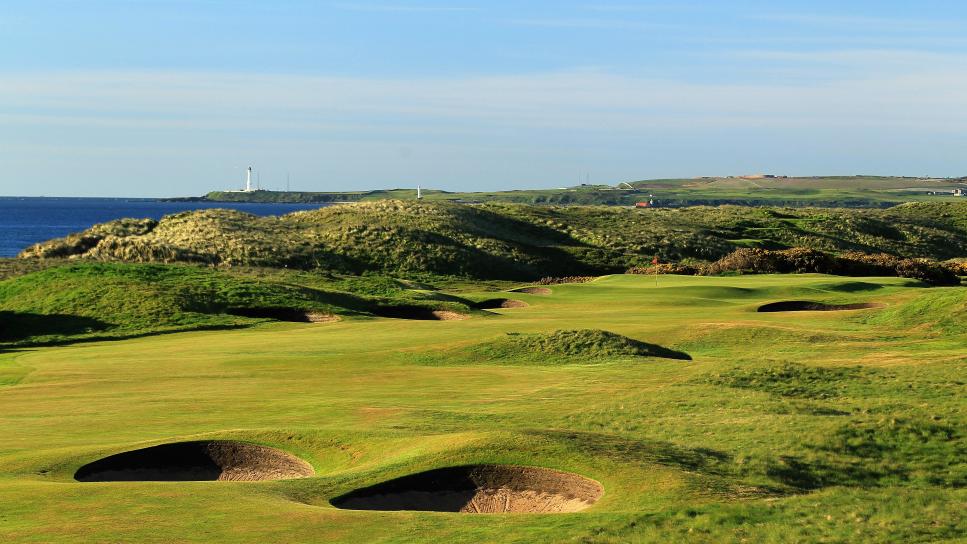
Photo by David Cannon/Getty Images
A powerhouse group of courses dominate the Aberdeen area. Kicking us off is the Balgownie Links at Royal Aberdeen, the sixth-oldest golf club in the world. It was founded in 1780 as the Society of Golfers at Aberdeen and golf has been played on the Balgownie Links (above) since 1888. The club hosted the 2005 British Senior Open, the 2011 Walker Cup and the 2014 Scottish Open. Its first nine holes are widely regarded as the finest outward nine in the world, running along the North Sea. Balgownie Links checks in at No. 64 on Golf Digest’s World’s 100 Greatest Courses. The five-minute rule for searching for golf balls—now down to three—was first introduced here in 1783.
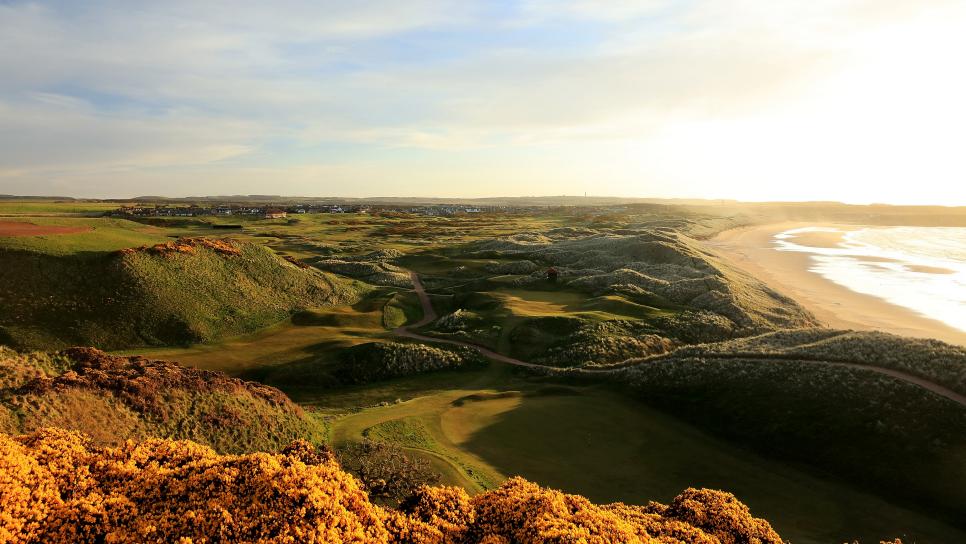
Photo by David Cannon/Getty Images
Though golf has been played in this location since 1791, it wasn’t until 1899 that the championship course at Cruden Bay (above) was opened for business. Perhaps more impressively, the design hasn’t been touched since 1926. The 6,600 yard masterpiece runs in a figure-eight along the North Sea with many of the holes separated from each other by three-story tall dunes. The course set among “stumpy dunes” features many blind shots, including consecutive ones into punchbowl greens on the par-4 14th and par-3 15th. Cruden Bay ranks 53rd on Golf Digest’s World’s 100 Greatest Courses.

Dom Furore
The newest of the bunch isn’t even a decade old. Opened in 2012 with the goal of hosting a major, Trump International Golf Links (above and opening photo) had to overcome many environmental objections and years of legal battles to become what it is today. The No. 42 on Golf Digest’s World’s Greatest Courses is set among as dramatic a set of dunes as any course in the world—some reach more than 100 feet above the fairways they frame. The tumbling fairways, stacked sod bunkers and perched greens make an excellent setting for tournament golf. Though it has yet to crack The Open rota, Trump International may one day host a Ryder Cup.
Sitting right alongside these giants of the Aberdeen golf scene is a hidden gem called Murcar Links Golf Club. Just 10 minutes north of the city and neighboring Royal Aberdeen, this is the perfect course for either a quick round squeezed in during a trip or as a second 18 after a tough test across the street in the morning. Murcar is no pushover itself, though. At 6,500 yards from the tips, this par 71 fights back with tight, rolling fairways, massive sand dunes and juicy, heathery rough. If the wind blows, which is not uncommon, this course can be a beast. It may not get all the same attention as these other titans, but Murcar is an absolute must-play when visiting Aberdeen.
Interested in booking one of these trips? Click here to start pricing out your trip with our friends at Golfbreaks by PGA TOUR, or call them: (+1) 843.779.7134.
St. Andrews
After over a year of postponed and altered trips, combined with St. Andrews being the most famous golfing city in the world, booking trips is quite complicated at the moment. Even for 2022, availability is limited, particularly because the 150th Open Championship is scheduled to be played at the Old Course at St. Andrews in July. That said, all the draws of the area still exist and will be there when it becomes easier to book trips again. The obvious pull factor is world-class golf, but St. Andrews has plenty more to offer in the way of pubs and restaurants. If your trip is really all about golf, though, you can combine the two and watch golfers play the famous 17th Road Hole at St. Andrews’ Old Course as you sit at the Jigger Inn or enjoy views of the first and 18th holes from Hams Hame Pub & Grill.
Within shouting distance of the home hole at the Old Course, the Ardgowan Hotel is the perfect lodging option for a trip centered around the St. Andrews courses, Carnoustie, Kingsbarns and Crail Golfing Society. The former are within walking distance, while the latter three are just a few minutes drive away. Given its location right at the edge of the most famous golf course in the world, there are plenty of food and beverage options nearby, including a restaurant that’s part of the hotel. It really doesn’t get much more convenient than this.
Also within walking distance of the Old Course and it’s St. Andrews companions is the Albany Hotel. For those willing to sacrifice a little more than a quarter of a mile to save some money on sleeping arrangements, this may be the perfect place. The Garden restaurant in the hotel serves a Scottish breakfast with local ingredients and the Bar Lounge is the perfect place to decompress after a day on the links and drink some seriously good Scottish whisky and beer.

It’s tough to be any more intrinsically linked to golf than the Rusacks Hotel (above). This recently remodeled hotel is quite literally a pitch and a putt away from the 18th hole of the Old Course. Though technically out of bounds down the right hand side of the hole, this five-star hotel couldn’t be a better place to watch golfers start and end their rounds. A golf concierge is available to answer any questions that may arise. Outside of golf, there are two restaurants in the hotel and guests are within walking distance of all the pubs, restaurants and shops that the city has to offer.
Just a block from the Old Course is yet another outstanding stay-and-play option. Six Murray Park is known for its incredible service and delicious breakfasts that are sure to give golfers the fuel they need to perform on the course during the day. There are just eight rooms in the Victorian style townhouse, so space is limited, but it’s well worth it if available.
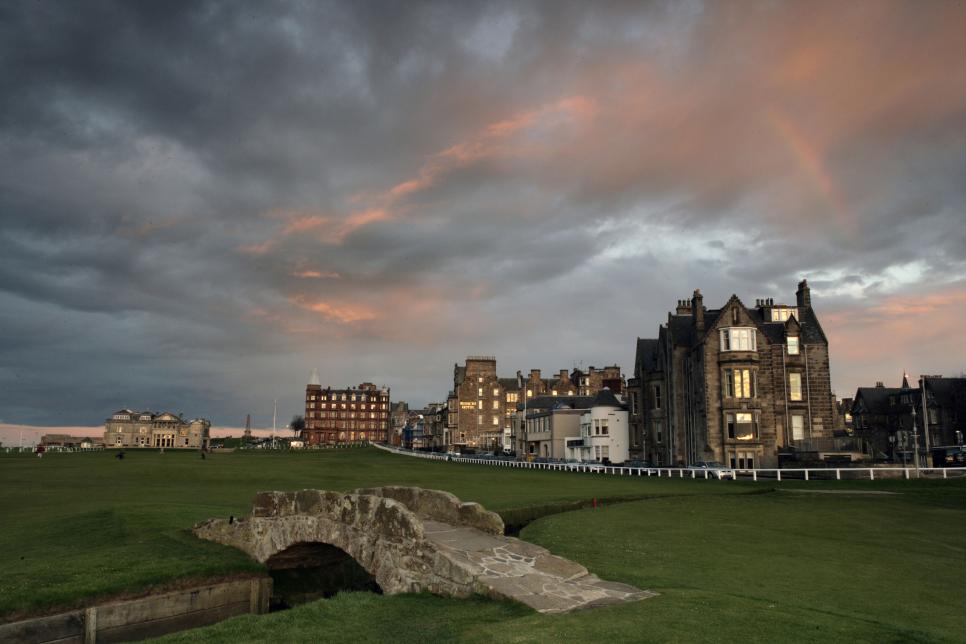
The Old Course. The Home of Golf. For those interested enough in golf to be taking a trip to Scotland, this course needs the least introduction of any. Golf has been played on this piece of land since 1553. The Old Course, No. 6 on Golf Digest’s World’s 100 Greatest Courses has hosted the Open Championship 13 more times than any other course still in the rota. It’s giant double greens, pot bunkers, blind shots and lightning fast fairways have influenced pretty much every hole designed since. Tiger Woods has won two of his three Open Championships on the Old Course (above).
While the Old Course gets all the hype, and rightfully so, the New Course at St. Andrews is deserving of plenty of praise, itself. In fact, if it were located almost anywhere else but in the shadow of the world’s most famous course, it probably would. The funny thing is, it’s not even that new. “New” is just relative. Designed by Old Tom Morris in 1895, the New Course features tighter fairways but less severe bunkering than it’s older St. Andrews neighbor. The locals love this course as it has a wonderful collection of par 3s and doesn’t get the same tourist attention as the Old Course. The R&A paid to have the New Course built in exchange for tee times at the Old Course, which is an agreement that still stands today.

Stephen Szurlej
Across St. Andrews Bay to the north lies another course in the Open Championship rota, perhaps the most difficult of them all. The Championship Course at Carnoustie has hosted eight Open Championships, most recently in 2018, won by Francesco Molinari. Carnoustie is different from the other Open courses as it is rare to get a glimpse of the ocean. Instead the water that has the players’ attention is demonic Barry Burn, which has claimed the hopes of many a would-be Champion Golfer of the Year—remember Jean van de Velde? The famously difficult three-hole closing stretch will rout golfers over (hopefully) Barry Burn at least five times. Carnoustie, No. 20 on Golf Digest’s World’s 100 Greatest Courses, is less than an hour’s drive from St. Andrews, making it a must-play for those staying in the area.
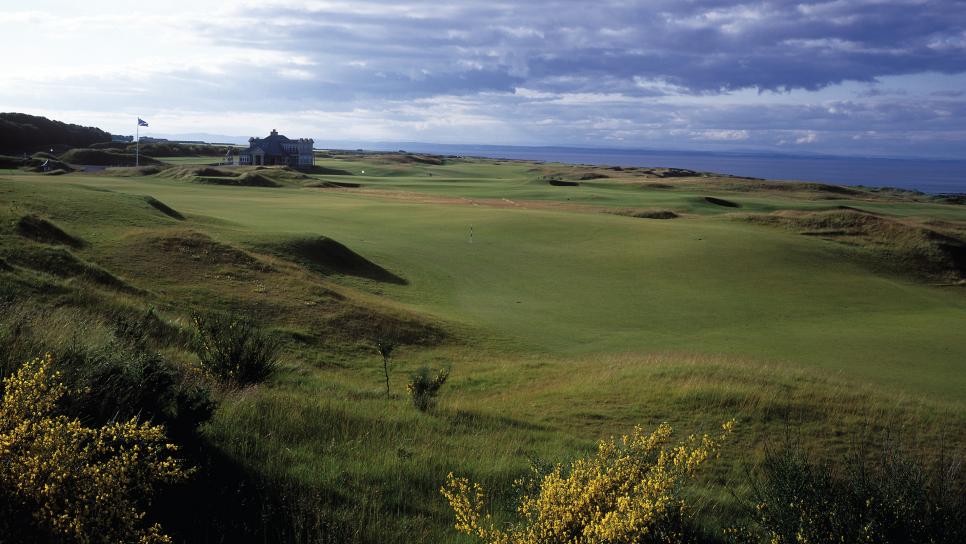
Courtesy of the club
Golf has been played on the land that Kingsbarns (above) occupies since 1793, but this particular course didn’t open until 2000. Just 20 minutes east of St. Andrews, No. 26 on Golf Digest’s World’s 100 Greatest Courses has the same hundreds-of-years-old feel as most other courses in the region while also holding the distinction of being one of few new coastal links developments in the United Kingdom. It’s so highly regarded, in fact, that it’s already part of the Alfred Dunhill Links Championship, a tournament centered around three courses that also includes the Old Course at St. Andrews and Carnoustie. That company is as elite as it gets.
A little over an hour west of St. Andrews is the PGA Centenary Course at Gleneagles, site of the 2014 Ryder Cup. This Jack Nicklaus design opened for play in 1993, and though it doesn’t get as much love as its Gleneagles neighbors, the King’s and Queen’s courses, it is a must-play. Set among hillocks and breathtaking scenery, Nicklaus called this "the finest parcel of land in the world I have ever been given to work with.”
No trip inland would be complete without a round at the King’s Course at Gleneagles. Though not as long, nor as brutally difficult as it’s newest neighbor, the PGA Centenary Course, various holes at the King’s course have been listed as the best in the world over the years, including the uphill par-4 fourth, the now-drivable par-4 14th and the short, par-4 17th. An informal match between Great Britain and the United States was played here in 1921, which laid the foundation for what we know as the Ryder Cup today.
For those looking to take the trip from St. Andrews north across the River Tay to Carnoustie, a stop at Panmure Golf Club is a wise choice. Two miles west of its Open Championship-hosting neighbor, Panmure has hosted Final Qualifying many times, as it boasts a championship-level test of its own. In 1953, Ben Hogan spent two weeks at Panmure to prepare for the Open at Carnoustie. He famously went on to win the only Open Championship he ever played in as he set the course record in the final round and won by four strokes. After his two weeks of practice rounds, he recommended that a bunker be added in front of the sixth green. The 414-yard par 4 is now named “Hogan.”
Located at the easternmost edge of the Fife peninsula, Crail Golfing Society is one of the oldest golfing societies in the world. There are two courses to be played, but the Balcomie Course, originally designed by Old Tom Morris in 1894, is the must-play of the two. A par-69, measuring just 5,922 yards from the tips, this course is often underestimated. But with winds whipping off the North Sea, yardages are often rendered meaningless. Sat right on the sea, golfers can enjoy views across the Firth of Forth toward North Berwick and Edinburgh.
Interested in booking one of these trips? Click here to start pricing out your trip with our friends at Golfbreaks by PGA TOUR, or call them: (+1) 843.779.7134.
Edinburgh and East Lothian
Edinburgh and East Lothian combine to form what’s known as “Scotland’s Golf Coast” with 21 courses along only 30 miles of coastline. East Lothian is famous for its natural beauty, sandy beaches, picturesque villages and rolling rural landscape. It also has an almost magical microclimate of its own, making it one of the driest and sunniest regions in Scotland, great for enjoying the largest concentration of championship links in the world.
Forty-five minutes east of Edinburgh, the Marine Hotel & Spa in North Berwick provides the perfect “home base” from which to explore Scotland’s Golf Coast. From here, visitors will have their pick of about two-dozen courses, including some of the oldest and most famous in the world in North Berwick, Muirfield, Gullane and Dunbar.
Also on the North Berwick coast just a couple minutes from the Marine Hotel & Spa is No. 12 Hotel & Bistro. Just 50 yards from the beach and within walking distance of pubs and restaurants, this family-owned and operated property has 11 rooms and a bistro-style restaurant onsite. This, similarly, is a fantastic place to set up shop for a trip to easily experience all the golf East Lothian has to offer.
About 10 minutes closer to Edinburgh—and for significantly less money—the Ducks Inn is the perfect budget option for those wanting to focus their spending on things other than lodging. Still just 5 miles from Muirfield and Gullane, the Ducks Inn is famous for its award-winning restaurant, making it a great place to eat and hang out with a glass of Scottish whisky after a long day on the course.
For those wanting to stay in the Scottish capital, Hotel du Vin in Edinburgh is a great option, right in the heart of the city. Still less than an hour from the Golf Coast, Hotel du Vin boasts an extensive wine collection, a cigar lounge and a French-style bistro restaurant. It’s just nine miles from the airport and within walking distance of pubs, restaurants and sightseeing attractions in the city.

Photo by Stephen Szurlej
For the golf courses, it would be impossible to kick things off without starting at Muirfield (above). The world’s oldest golf club, dating back to 1744, has hosted 16 Open Championships, the second-most of any course still in the rota. It’ll require some advanced planning to be able to book a tee time, but a morning round, lunch at the clubhouse and an afternoon game will make for one of the best golf days one could have. Gary Player, Jack Nicklaus, Lee Trevino, Tom Watson, Nick Faldo, Ernie Els and Phil Mickelson all lifted the Claret Jug at Muirfield, the No. 3 course on Golf Digest’s World’s 100 Greatest Courses. The club voted in 2017 to allow female members after 273 years of being an all-male club.
Gullane Golf Club is home to three courses, two of which are must-plays. Gullane No. 1 is a Final Qualifying site for the Open and has hosted the Scottish Open. About 40 minutes east of Edinburgh, Gullane No. 1 overlooks the Firth of Forth as it’s carved into ancient, sandy links turf with pot bunkers and wispy grasses aplenty, ready to swallow wayward golf shots. Golf on this land has been traced back to the 1600s, but the architect of this par-71, 6,873 yard gem is unknown. This course will test uphill and downhill shotmaking and the seventh hole, in particular, will provide a 360-degree view of some of the best courses in the world and the Scottish coastline.
The second of three courses at Gullane Golf Club, aptly named Gullane No. 2, is shorter than No. 1, but will test golfers just as well. Final Qualifying for the Open has also been held here along Aberlady Bay. The beautiful Scottish coastline is an awe inspiring backdrop, but golfers mustn’t let it distract them from their play, or else big numbers on the scorecard may await. When Willie Park Jr., who was then the Champion Golfer of the Year, designed No. 2 in 1898, he did so for 10 guineas, or about 10 and a half Euros in today’s money.
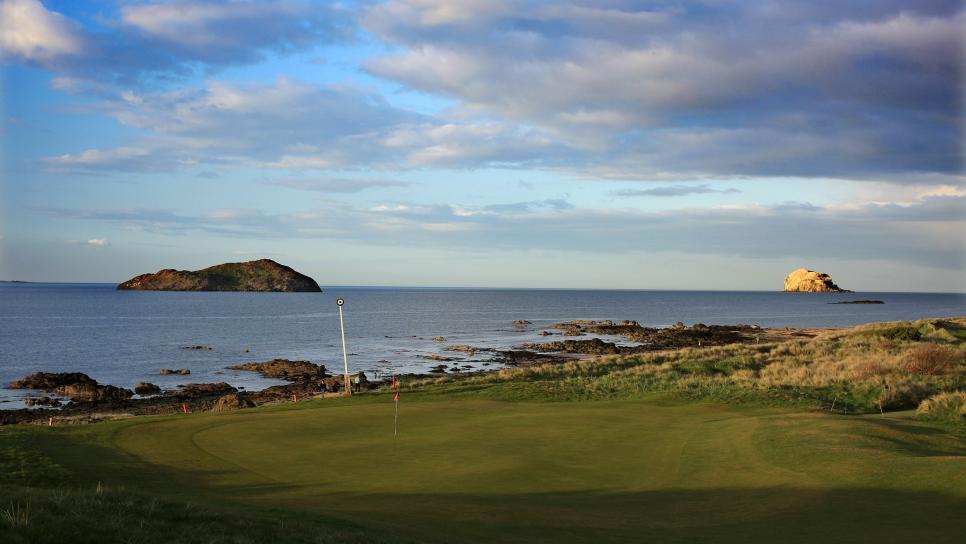
David Cannon/Getty Images
Founded in 1832, North Berwick Golf Club (above) is the 13th-oldest club in the world. Checking in at No. 39 on Golf Digest’s World’s 100 Greatest Courses, North Berwick must be played with a sense of humor to avoid being frustrated by it’s difficulty and unusual layout. The 13th green is sunken behind a stone wall, the par-3 15th Redan is blind from the tee and the narrow 16th, which features a gulch that separates the front and black plateaus, is surely the inspiration for the Biarritz green, though architecture purists will argue otherwise. North Berwick isn’t unbearably long and prides itself on fast play. As a result, the rough is kept relatively short. Instead wind, the natural humps and bumps of the land and atypical golf topography are the course’s defense.
Golf has been played on the land that Dunbar Golf Club occupies since the early 17th century, but the club wasn’t officially formed until 1856. Another Final Qualifying site for the Open, Dunbar East Links (as the locals call it), is a 40-minute drive east of Edinburgh. At just over 6,500 yards, Dunbar isn’t particularly long by modern standards, but golfers aren’t taking trips to Scotland to play long courses. Dunbar, as do so many others in the area, provides a classic links test along the sea, with wind and the natural topography of the land placing a premium on club selection and shot-making.
Half an hour east of Edinburgh is Kilspindie Golf Club, the 35th registered club in the world. It was originally called Luffness Golf Club before that club relocated to the other side of Aberlady Bay. An historical gem in East Lothian, Kilspindie has been relatively untouched since it was opened in 1867. It’s just 5,500 yards with only one par 5, four par 3s and seven of 13 par 4s measuring less than 300 yards. This course serves as a perfect introduction to the links style of the Golf Coast. Legend has it that two aces were made on consecutive days on the signature eighth hole, which plays at 162 yards—one with a wedge, the other with a 3-wood.
Glen Golf Club is the perfect example of a hidden gem overshadowed by a titan of the game sitting next door. Just a few hundred yards from North Berwick, Glen Golf Club offers fantastic views of the Firth of Forth and Milsey Bay. Glen opened in 1906, this course will test a player’s ability to navigate through elevation changes as the course is routed along seaside cliffs. The par-3 13th is often regarded as the greatest par 3 in Scottish golf as players hit from an elevated tee down to a green hanging off a cliff-edge. The 18th also runs along the coast and players will descend over 100 feet from tee to green.
The Renaissance Club, host of the 2021 Scottish Open, offers a unique program for visiting golfers. Travelers may sign up to be a member for the day—on a Monday or Wednesday—to get the full experience. But after that, they are unable to come back to use the facilities a second time. That’s a clear sign to make sure that one truly enjoys one’s time at the club while it lasts. Though it was only opened in 2008, the land it sits upon is steeped in history. Originally part of the Archerfield Estate, golf on this land dates back to the 16th century. The rolling fairways, wispy grass and natural contouring all help to make this course look as perfectly placed as its centuries old neighbors.
Right next door is Archerfield Links, home to Fidra Links, a unique mix of Scottish golf among the pines and the traditional fast-running links one would expect. Fidra Links is stuck right between Muirfield and North Berwick and even though it just opened in 2004, it fits right in among its long-established neighbors.
Interested in booking one of these trips? Click here to start pricing out your trip with our friends at Golfbreaks by PGA TOUR, or call them: (+1) 843.779.7134.
Southwest Scotland
While St. Andrews may be “The Home of Golf,” it was the Ayrshire coastline in the southwest of Scotland where the first Open Championship was played. The world-famous Prestwick, Turnberry and Royal Troon Golf Clubs are complemented by a handful of other gems along the Firth of Clyde.
A 40-minute drive south and west of Glasgow is Piersland House, the former residence of the Johnnie Walker Scotch Whisky family. The house, which sits opposite Royal Troon Golf Club and is an easy drive from several other area courses, has 37 rooms and a restaurant and bar on site and is just a few hundred yards from the beach.

A bit farther south is Trump Turnberry (above). The hotel has long been an iconic landmark on the Ayrshire coastline and offers a wide array of rooms for guests. 1906 is Turnberry’s signature restaurant, named for the year the hotel first opened. In the clubhouse, The Duel in the Sun Restaurant pays homage to the battle between Jack Nicklaus and Tom Watson that took place at the 1977 Open Championship. In addition to golf, the resort also offers, shooting, archery, falconry, clay shooting, water zorbing, horse riding, quad biking and 4x4 off-road driving.
Back north by Troon, and at a relative bargain, the South Beach Hotel is a family-run hotel. With quality golf on its doorstep and two restaurants and a bar that shows live sports, this lodging option is hard to beat. Views of the Isle of Arran and Ailsa Craig will eliminate any thoughts of South Beach, Miami.
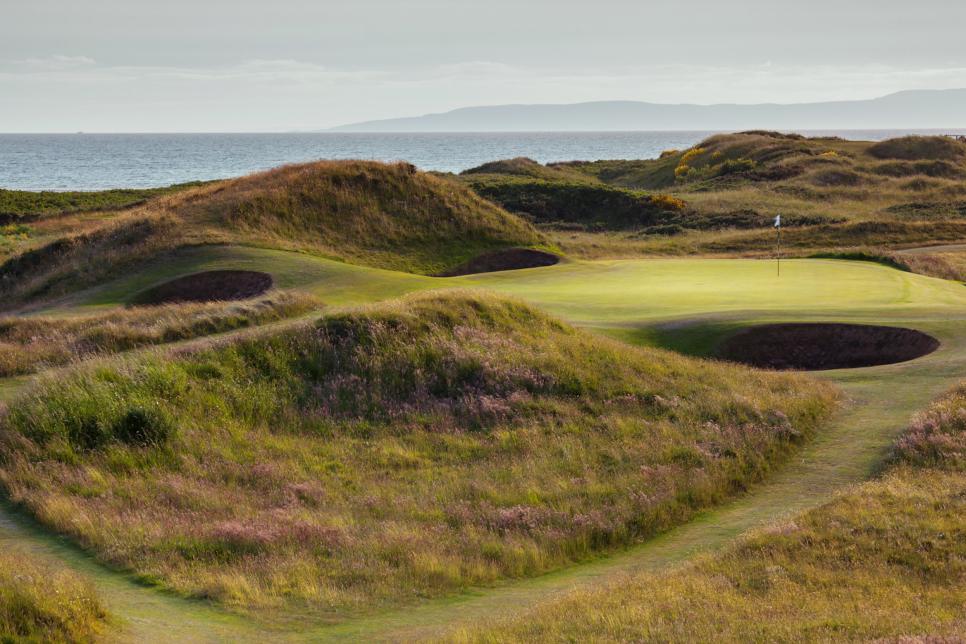
Photo by Mark Alexander
Another Old Course in Scotland, the Old Course at Royal Troon (above) is one of the toughest Open Championship venues. As many links courses are, Troon is routed out and back along the Firth of Clyde with the first nine typically playing downwind while players battle the prevailing winds as they head back for the clubhouse. The eighth hole, a 123-yard par 3 is the world-famous “Postage Stamp,” aptly named for its tiny green. It’s just a wedge in calm conditions or when the prevailing winds blow, but if the wind changes, a mid-to-long iron approach is necessary. Many scorecards have been and will be wrecked at the eighth. Troon, No. 49 on Golf Digest’s World’s 100 Greatest Courses, has hosted nine Open Championships, with a 10th scheduled for 2024. Americans won six straight Opens at Troon before Sweden’s Henrik Stenson outdueled Phil Mickelson, returning the favor for Lefty’s 2013 Muirfield triumph.

David Cannon/Courtesy of Turnberry
Farther down the coast, Turnberry is home to two championship courses. The Ailsa Course at Turnberry (above) is known as the most scenic on the Open rota. Named for its views of the spectacular granite island called Ailsa Craig, in the Firth of Clyde, along which the course is routed, there are few more picturesque places for golf. Turnberry first hosted the Open in 1977 as Tom Watson bested Jack Nicklaus in The Duel in the Sun. Turnberry has hosted four Opens, most recently in 2009, when Watson, again, was at the center of the tournament. The then-59-year-old was outlasted by Stewart Cink, who claimed his only major championship in a playoff. Without a future Open assigned to the course, the Ailsa Course went through a full facelift in 2015, with every hole receiving some touch ups. The Ailsa Course is No. 10 on Golf Digest’s World’s 100 Greatest Courses.
Sharing a property with a world-class course can’t be easy, but King Robert the Bruce at Turnberry, opened in 2017, has turned the resort into a true 36-hole destination. Named in honor of the man who was raised in Turnberry Castle and became King of Scots in 1306, King Robert the Bruce checks in as a par-72 at just under 7,000 yards. In front of the hotel, there is an 18-hole pitch-and-putt course called “The Wee” in case the two full-sized courses aren’t enough fun.
Before Royal Troon or Turnberry got their moments in the spotlight, Prestwick Golf Club was hosting Open Championships left and right. Prestwick hosted the first Open in 1860, and the next 11 thereafter from 1860-1872, since there was no Open in ‘71. It’s hosted a second-best 24 times, but not since 1925. As golf’s popularity grew, more spectators came to watch and Prestwick’s cramped layout made it difficult to control crowds. In 1925, many spectators were struck with errant shots as they severely outnumbered the marshals there to keep them in place and players complained that the overwhelmingly large crowds affected their play. One of the most intimidating opening tee shots in golf awaits as a railway line is directly in play. Those wishing to make use of the member’s bar and dining room after their round must remember a jacket and tie.
Just like Prestwick, Western Gailes Golf Club is situated between the Firth of Clyde and the Ayrshire Coast Line railway. Though it doesn’t have the same illustrious reputation as its neighbors in the southwest of Scotland, Western Gailes more than holds its own, while also being far more affordable. Host of the 1972 Curtis Cup, these links change direction three times, making choosing the correct tees a priority. The idea for a club came from four friends from Glasgow who wanted somewhere to play outside of the industrial fog of the city.
Between Prestwick and Troon is Dundonald Golf Links, formerly known as Southern Gailes before it was purchased by Loch Lomond Golf Club in 2003. Dundonald is named for the remains of “Fort Donald” that were discovered nearby and traced back to 200 BCE. The course was opened in 2005 and has served as host to European Tour Qualifying School and the men’s and women’s Scottish Opens. Tipping out at over 7,100 yards, this par-72 is not for those looking for an easy stroll on the links, as pot bunkers and a burn harass golfers on several holes. A golf course existed on this property in the 1900s, but was converted to a military training base where D-Day landings were rehearsed.
Gailes Links is part of the prestigious Glasgow Golf Club, founded in 1787, making it one of the oldest in the world. Gailes opened in 1892 and was redesigned by Willie Park Jr. in 1912 to serve as a complementary links-style course to the members’ parkland course in the city. It has since hosted several international championships and served as a qualifying course for the Open. The Tennant Cup is the oldest open amateur stroke play trophy in the world and has been hosted by Glasgow Golf Club since 1880. The first 36 holes are played at Gailes Links before the final 36 are played at Killermont, the club’s parkland course in Glasgow.
About 45 minutes northwest of Glasgow, Loch Lomond is a Tom Weiskopf design that tosses aside the familiar seaside links golf many will play on their trip to Scotland in favor of a more tree-lined setting with mountainous backdrops and manicured fairways. The views at Golf Digest’s No. 11 course in Scotland are breathtaking. After opening in 1993, Loch Lomond hosted the Scottish Open from 2001 until 2010. Weiskopf called it his “lasting memorial to golf.”
Interested in booking one of these trips? Click here to start pricing out your trip with our friends at Golfbreaks by PGA TOUR, or call them: (+1) 843.779.7134.